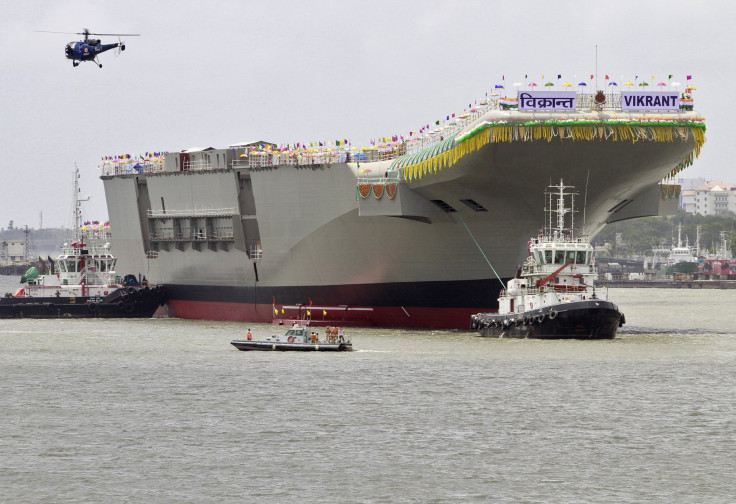Members Only: India Launches First Homemade Aircraft Carrier, Raising Alarms In China

India has launched its first domestically manufactured aircraft carrier, the INS Vikrant, joining only the elite club of U.S., Russia, France and Britain as nations with such engineering/military capabilities. The launching of the 37,500-ton carrier was officially blessed on Monday at the Kochi shipyard in Kerala, on India’s southwestern coast, by Elizabeth Antony, the wife of Indian Defense Minister A.K. Antony. The launch denotes the end of the first phase of the Vikrant's construction as it will be now re-docked for outfitting of the superstructure.
"It is a red-letter day for the entire nation and a proud moment for the country which has achieved self-reliance in the field of warship design and construction,” the defense minister said at the launching ceremony. “Only a few advanced countries have capability to design and build such aircraft carriers," adding that the Vikrant represents an "important" first step in the development of more warships. Antony also noted that the Navy must remain vigilant and maintain "high operational preparedness to thwart any likely misadventure against our national interest."
The carrier will carry various weapons systems and also include Russian-made MiG-29K fighter jets and Light Combat Aircraft as well as Russian-made Kamov-31 helicopters on board. Also, upon completion, the Vikrant will boast long-range and surface-to-air missiles. The Vikrant’s high-grade steel was manufactured by the Steel Authority of India, while all the design and manufacturing was accomplished domestically. But the Vikrant warship, which is 260 meters (853 feet) long and 60 meters (197 feet) wide, is at least three years behind schedule and set to undergo extensive trials in the year 2016. By the end of 2018, Vikrant is expected to be commissioned and join the Indian navy.
Currently, India operates one aircraft carrier, the INS Viraat (transferred to India by the British Navy in 1987) which will likely be decommissioned in 2018 or 2019 after the Vikrant becomes operational. Another aircraft carrier from Russia, the Admiral Gorshkov, to be renamed INS Vikramaditya, is expected to be delivered by the end of this year. PTI reported that the Indian Navy plans to use each carrier on its eastern and western seaboards and also plans to build more, much larger, domestic carriers in the future.
“When INS Vikrant is commissioned, India aims at becoming a dominant sea power in this region," said Delhi-based expert Ravi Desai, according to the Xinhua news agency. "The launch is the crowning glory of the Indian Navy's program to produce vessels on home soil," the deputy chief of the Indian Navy, Vice Admiral R.K. Dhowan, said.
All of these developments have India’s giant neighbor and rival China on edge. According to a report in Press Trust of India (PTI), the debut of the Vikrant has caused great concern in Beijing, partially due to fears that the Indian Navy may now penetrate deeper into the Pacific Ocean, which the Chinese regards as its own. The decision by the US military to rebalance its resources to the Asia-Pacific region already has Beijing alarmed.
Zhang Junshe, vice-president of China's Naval Research Institute, warned the China Central Television (CCTV) that India will soon become the only country in Asia to have two aircraft carriers. “This will enhance the overall capabilities [and] especially the power projection capabilities of the Indian Navy," he said. Zhang also told the China Daily newspaper that "India's first self-made carrier, along with reinforced naval strength, will further disrupt the military balance in South Asia,” suggesting Indian naval forces may now have the ability to patrol in distant seas, posing a direct challenge to the traditional naval superpowers, China and the U.S.
In 2012, the Chinese launched their first aircraft carrier, the Liaoning, however its hull was taken from the Russians and redesigned and refurbished in China. Reportedly, China is constructing two more aircraft carriers, but their release dates are unknown. Wang Daguang, a Beijing-based researcher of military equipment, commented that India’s new “indigenous carrier will further strengthen India's naval power and also add some bargaining chips with the world's major military vendors such as Russia," according to PTI. But Zhang also conceded that both India and China should build more carriers given their lengthy coastlines and the premium placed on protecting crucial sea lanes to move trade.
The Global Times, a Chinese paper run by the Communist Party, Beijing does not think India and the US can form an alliance to serve as a bulwark against Chinese sea power in the Pacific. “According to the U.S. geostrategic desires, in order to push India to integrate into its system to contain China, the U.S. not only encourages India to move east but also brings up the concept of an ‘Indo-Pacific’ to justify India’s intervention in Asia-Pacific affairs,” commented Fu Xiaoqiang of the China Institutes for Contemporary International Relations (CICIR), a Beijing think-tank, in the Times. “However, India still has various concerns over the U.S. rebalancing strategy for the region. On the one hand, New Delhi worries this may stimulate China to develop weaponry and draw India into an open confrontation with China. This is obviously far from India’s interests, since India prefers balancing China naturally by ensuring peaceful and fruitful competition. India has no intention of becoming a regional test balloon by going against China.”
According to the Xinhua news agency of China, India’s navy now has more than 58,000 personnel, as well as a large fleet that comprises British-made aircraft carrier, 15 frigates, nuclear attack submarine, an amphibious transport dock, eight guided missile destroyers, 14 conventional submarines, 24 corvettes, 30 patrol vessels, seven mine countermeasure vessels and several auxiliary ships.
The New Delhi government is reportedly planning to spend billions of dollars to upgrade its mostly Soviet-era military equipment.
© Copyright IBTimes 2024. All rights reserved.











